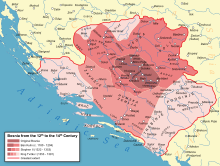Bosnia (region)
Bosnia
Bosna Босна | |
|---|---|
Region | |
UTC+2 (CEST ) |
Bosnia (
The two regions have formed a geopolitical entity since medieval times, and the name "Bosnia" commonly occurs in historical and geopolitical senses as generally referring to both regions (Bosnia and Herzegovina). The official use of the combined name started only in the late period of Ottoman rule.
Geography
Bosnia lies mainly in the
marking its northern and eastern borders.The area of Bosnia comprises approximately 39,021 km2,[1] and makes up about 80% of the territory of the present-day state of Bosnia and Herzegovina. There are no true borders between the region of Bosnia and the region of Herzegovina. Unofficially, Herzegovina is south of the mountain Ivan planina. According to another unofficial definition, Herzegovina encompasses the watersheds of the Neretva and Trebišnjica rivers.
History
The Central part of Bosnia was inhabited by Neolithic farmers that belonged to the Kakanj culture, and later replaced by another neolithic culture called the Butmir culture. The first Indo-Europeans are thought to be members of eneolithic Vučedol culture.[2]
In the
The historical records of the region are scarce until its first recorded standalone (domestic) ruler and viceroy of Bosnian state, Ban Borić, was appointed in 1154.
Under its first known by name ruler, Stephen, Duke of Bosnia, in the 1080s, the region spanned the upper course of the rivers Bosna, the Vrbas and the Neretva.[citation needed]

At the end of the 14th century, under Tvrtko I of Bosnia, the Bosnian kingdom included most of the territory of today's Bosnia and of what would later become known as Herzegovina.
The kingdom lost its independence to the Ottoman Empire in 1463. The region of Bosnia's westernmost city at the time of the conquest was Jajce.[6]
The Ottoman Empire initially expanded into Bosnia and Herzegovina through a territory called the
Eventually, following the Great Turkish War, in the 18th century the Eyalet came to encompass the area largely matching that of today's Bosnia and Herzegovina.
In 1833, the
Regional identity
Within
Subregions
- Podrinje, eastern
- Bosanska Krajina, northwestern
- Central Bosnia, central
- Posavina, northernmost
- Semberija, northeastern
- Tropolje, western
See also
- History of Bosnia
- Herzegovina
References
- ^ "Land area (sq. km) - Bosnia and Herzegovina | Data". data.worldbank.org. Archived from the original on 2021-05-06. Retrieved 2021-05-06.
- ^ Supporters of Gimbutas' "kurgan model" of Indo-European expansion identify both the preceding Baden culture and Vučedol as Indo-European speakers, though no trace of a written language for either can be expected; see Mallory and Adams, eds., Encyclopedia of Indo-European Culture, 1997; "A succession of Kurgan 'waves' of expansion was set out, the fourth influencing the Vucedol culture of Yugoslavia. This was significant for the further 'Kurganization' of Europe by the Bell Beaker people." (Colin Renfrew, Archaeology and Language: the puzzle of Indo-European origins, 1990:39)
- from the original on 2015-01-28. Retrieved 2012-09-12.
Bosna u obujmu, u kakvom se navodi u djelu DAI kao jedinstvena teritorijalna jedinica, protezala se, kako neki autori smatraju, na području u kojem su prije prebivali Desitijati (M. Hadžijahić). Ti Desitijati, koji su nastavali istočnu i srednju Bosnu počevši od Travnika prema Rogatici pa dalje, imali su središte oko današnje Breze. (Mandić 1942, str. 133.)
- ^ Vladimir Ćorović, Teritorijalni razvoj bosanske države u srednjem vijeku, Glas SKA 167, Belgrade, 1935, pp. 10-13
- ^ Mrgić-Radojčić 2004, p. 52–53.
- ISBN 0-932885-12-8. Archivedfrom the original on 2023-02-15. Retrieved 2012-05-06.
... in Bosnia Jajce under Hungarian garrison actually held until 1527
- ^ Moravcsik 1967, p. 161.
- ^ Ramet 1989, p. 303.
- ^ Donia & Fine 1994, p. 71-74.
Sources
- ISBN 0-472-08149-7.
- ISBN 0-472-08260-4.
- Donia, Robert J.; Fine, John Van Antwerp Jr. (1994). Bosnia and Hercegovina: A Tradition Betrayed. New York: Columbia University Press.
- ISBN 9780884020219. Archivedfrom the original on 2023-01-20. Retrieved 2018-12-30.
- Mrgić-Radojčić, Jelena (2004). "Rethinking the Territorial Development of the Medieval Bosnian State". Историјски часопис. 51: 43–64. Archived from the original on 2023-02-15. Retrieved 2018-12-30.
- ISBN 0822308916. Archivedfrom the original on 2023-02-15. Retrieved 2019-06-18.
- Živković, Tibor (2010). "On the Beginnings of Bosnia in the Middle Ages". Spomenica akademika Marka Šunjića (1927-1998). Sarajevo: Filozofski fakultet. pp. 161–180. Archived from the original on 2020-08-09. Retrieved 2018-12-30.
